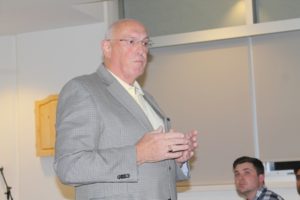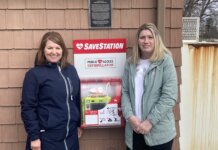
BEAVER BANK: The developer of a contentious proposed 218-unit development on Windgate Drive in Beaver Bank was on the hot seat again during a community open house at the Beaver Bank-Kinsac Community Centre on Sept. 28.
Dennis Rogers, the developer, did something most developers don’t—he came back to the community on his own accord. Rogers and WSP Canada planner Kourosh Rad did so to let the community to see the conceptual changes that have taken place in their proposal since the first meeting in February. That meeting was held as part of the Halifax Regional Municipality (HRM) development agreement process. This was on their own accord and was not required of them.

Traffic once again was an issue on the forefront, as it was during the first meeting. Another top concern: the fact that schools in the area are already at or over capacity and adding extra homes will only make that situation worse.
Resident George Mitchell was hesitant about seeing another development go forward without the infrastructure needs there first.
“We don’t have a great track record in the community with HRM as far as their foresight in planning, planning for schools, planning for water/sewer, yet developments continue,” he said. “I’m not suggesting, and I don’t think anyone here is suggesting, that it should be the developer’s responsibility.”
The revised plans will see a reduction in the number of homes in the development from 265 to 218, with more of the development focused on single lot homes, 101 up from the original plan for 55. Clustered single lots decreased from an initial 46 to 17; town homes were reduced from 44 to 20; and multi-unit dwellings saw a reduction from 120 to 80. There is no longer any commercial development as part of the proposal.
Mitchell wondered what the costs will be as residents have already been left with betterment charges for several things.
“Poor planning equals consumer pays,” said Mitchell. “We just see the future as reactive by HRM and not necessarily your fault, but when we sit down with councillors and such make it known to them that HRM doesn’t have a great track record. If they’re going to allow the development to happen please look forward and plan appropriately. Plan for the schools, plan for everything else. That’s a lot of families, that’s a lot of traffic, that’s a lot of sewage.”
Another concern was regarding whether or not local schools would be ready to accept the volume of kids that could come. The nearest school, Beaver Bank-Monarch Drive, is already overcapacity.
“That’s a question for HRSB,” said Rad. “We’re looking to meet with them, but haven’t had any luck yet.”
One resident summarized his thoughts on the development.
“We bought houses here to look at the trees and the scenery, not to look at condos,” the man said.
“We want to see buildings that fit in the community,” said another resident.
Councillor Brad Johns reiterated the meeting was being held by the developer so they could gauge the community before going back to HRM. He commended Rogers for doing so.
One issue that council candidate Kevin Copley mentioned was the fact the development has no sidewalks.
“Everything the crowd is saying you guys are saying you’re doing it, but I don’t see any of that,” said Copley. “There’s no incentive for an elderly person to move out here because your building buildings that are condos or apartments that are everywhere. There’s nothing about this that screams ‘I’m retiring and I’m going to move out to this area.’
“Complete communities have sidewalks. Complete communities have transit. Complete communities have green space that people can walk to and congregate at. And talk about community, all we have here is a bunch of houses in one big space.”
He took issue with Rogers saying he shouldn’t have to put money, as other developers are now, to make communities more complete.
“Your saying that you shouldn’t have to be the developer that has to do that,” said Copley. “This is exactly what’s going on in HRM and wanting the developer to chip in more. When do developers start building complete communities to make these communities safer for people?”
Rogers said it is his hope to get the development approved by North West Community Council. If approved there would be six months to do planning and design before construction would begin. It won’t all be done in one shot, but rather over many years.






